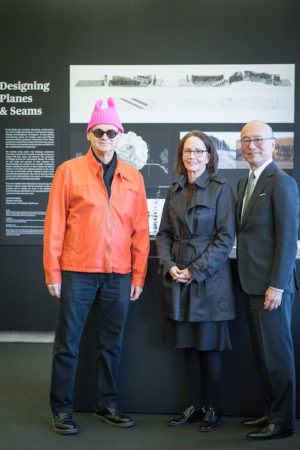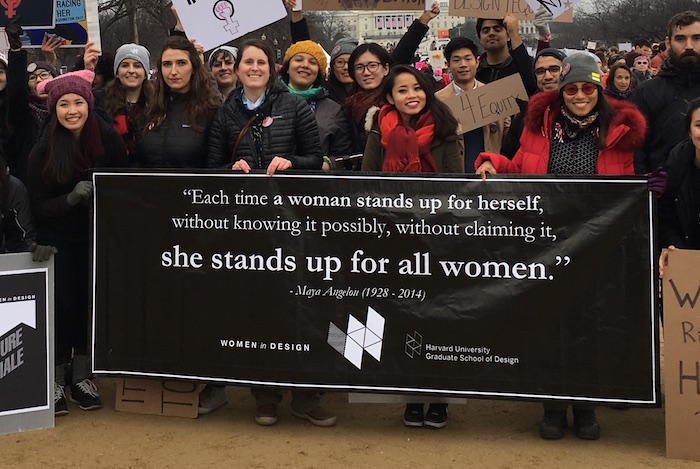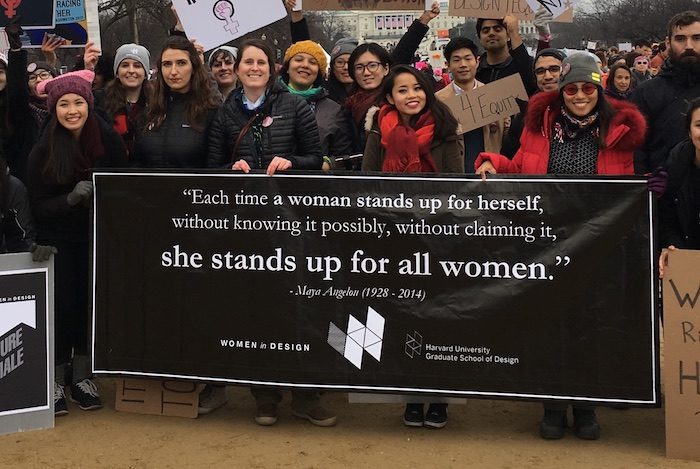By now you have most likely seen the perked ears of a pink “pussyhat” adorning the head of a friend, neighbor, or celebrity. Perhaps you have even knit one of your own. While this quiet form of protest was initially designed as a clever way to keep warm at the January 21, 2017 Women’s March on Washington, the pussyhat has taken on a symbolic significance, sparking a global movement of its own.
Composed of a simple knit rectangle, the pussyhat can be traced to two California women, one of whom, Jayna Zweiman, attended the Harvard University Graduate School of Design. The GSD recently spoke to Zweiman (MArch ’08)—architect, feminist, and co-founder of the Pussyhat Project—about how her time at Harvard inspired her current activism and the role of design as a tool for change.
Graduate School of Design: How did you get involved in the Pussyhat Project? Are you a long-time knitter?

Jayna Zweiman: I learned to knit because of the GSD! I was a recipient of the Edward Larrabee Barnes Grant to study sculptural knitting at Haystack Mountain School of Crafts. I explored knitting as material research: I was interested in how lines become surfaces and then forms, as well as the potential of encoding information. Knitting is the clearest diagram of surface composition. It’s the manifestation of textured trace.
After entering the professional world, my exploration of knitting as material research was put on hold until I faced a dilemma of how to recover from a concussion. I got back into knitting as a way of exercising my fine motor skills and a route back into making. Using knitting as a mode of therapy brought to front of mind the research I had begun into the physical and conceptual potential of knitting.
Then, in 2016, the political environment changed radically. I realized that I could not participate in traditional forms of political resistance and activism while in recovery, but I desperately wanted to be part of the movement. As I relearned to knit at The Little Knittery, I got to know Krista Suh, my friend and co-creator/founder of the Pussyhat Project. We talked about things she could do to have an impact beyond one person. Krista wanted to make herself a hat to protect herself from DC’s cold January weather, and then thought to have other people send in hats, too. I took it one step further and envisioned hat-wearing as a large-scale active-art installation. I thought the process of making, gifting, sharing, and getting the hats to DC marchers could be an opportunity for visibility and empowerment. I saw that this could be more than a moment—it could be a movement. It had the potential to go beyond even the millions of people who showed up in person to march to the millions of people creating hats, too.
We teamed up and made the Pussyhat Project. I am currently unable to be in large crowds, a limitation that inspired the project’s framework allowing everyone to take part and be visible. There are so many reasons why a person may not be able to be on the frontlines—it could be because of health, finances, or scheduling. Through Pussyhat Project, a person could be a knitter, marcher, both, or neither and find a way to be part of the project. The pussyhat harkens back to my initial research of knitting: it is a stripped-down diagram of a hat or pixel—a pattern that is created to be accessible.
The pussyhat is an artifact we could share to create a network and linkage between people who could materially be present at the march and those who create and give materiality through the act of making. It is an intimate manifestation of support. When a marcher wears a hat, she is not just representing herself, but also the maker of her hat. When a knitter shares a hat, she also shares a note about what women’s rights issue is important to her. When we see one million people wearing pussyhats, we are seeing the representation and connections of far more people.
GSD: You’ve spoken about how an option studio on architecture and social inclusion helped prepare you for your work with the Pussyhat Project. Could you elaborate?
JZ: When I was at the GSD, I had the opportunity to take a studio with David Adjaye. I have always admired his ideas around social inclusion as an unapologetic part of his principles and politics. He is one of a few influential architects who have taken on this attitude and it is incredibly inspiring. Adjaye has also expanded the disciplinary practice of architecture to include collaborations within the arts, which is an approach I have been developing in my own work over the years.

It’s an axiom that architecture is where people meet. As architects, we have an opportunity and a responsibility to make it more than that, as well: a place where they mix in the truest sense of the word. Pussyhat Project is about deep social encounters; it is contextual and it is multiplicitous. The space of resistance is the context of this project. The new datum are pink pixels, each a different hue.
In the past few decades participatory design has been used as a trope where an expert asks community members what they want to see. Pussyhat Project is a different version of participatory design—we proposed a process that people can take part in, or not. It leaves room for agency, individualization, and conjecture in each element. When all the elements of pink pixels come together, we see a communion of empowered individuals. The process of making pussyhats is also participatory and creates space to talk about political issues as a part of the process of craft. It lays the groundwork for future political participation.
GSD: Could you comment on the semiotics of the January 21, 2017 Women’s March—specifically the return to the handmade (knitting, magic markers, poster board) in our smooth, high-tech world?
JZ: The pussyhat strips a hat down to its essential diagram. It provides an iconography to the individual within the collective. It is playful, has the audacity to call out sexism of those in power while focusing attention on the power of the gender. Everyone can take charge of the signifier—an idea that is incredibly feminist.
The project is rooted in feminist practices of women knitting together to support political action that has spanned centuries. In the United States, women were knitting Liberty Caps during the Revolutionary War and hosted knitting circles as opportunities for political discourse. What is quite different is that the scale is contemporary. Pussyhat Project operates on a scale we have never witnessed and harnesses those knitting circles.
We see a multiplication of the signifier through contemporary channels: the pattern and framework for creating the pussyhat depended on social networks. Communication for this project was based on both physical and virtual connections—a physical network of local ally yarn stores and knitting circles that brought women together to learn, teach, discuss, and join together, and social media and the dance between the two. The interplay of local participation within a national network helped the project to succeed.
GSD: What do you think it will take for the Pussyhat Project to endure past the discrete occasion of the Women’s March?
JZ: It already has. Because of the success of the sea of pink, we continue to see the pussyhat used as a symbol of solidarity and support for women’s rights and political resistance.
We have seen images of a person wearing a pussyhat in Russia protesting the legalization of domestic violence. We have seen many people give newborns their first pussyhat to show how important women’s rights are from the very beginning. We have heard of an elderly woman choosing to die and be cremated in a pussyhat as a final stand for women’s rights.
Pussyhat Project is about both the hats and the process. Women’s rights supporters have been coming together in knitting circles and are discussing politics and political activism. Participants are continuing to make them, and–post-march–new participants are learning to knit to be able to make pussyhats, and demand for the pussyhats remains very high.
We recently launched Pussyhat Global Virtual March in honor of International Women’s Day/ A Day Without a Woman (March 8, 2017). The idea is that any women’s rights supporter anywhere, whether she is marching, striking, both or neither can join in our virtual march. We ask she/he put on her pussyhat, make a sign about where she is from and what she is for, hold it up, take a picture and share on social media. The idea is that we will all be able to see each other together. There are pussyhat gatherings happening right now around the world.

GSD: More broadly, how do you see design playing a role in protest movements against the current administration?
JZ: Design should be leading the way on how we organize, maneuver, and participate politically. Protest movements require creativity, clarity, meaning, and mass, all skills that designers have. We also live in an incredible visual time, and being able to create powerful images can help effect change.
GSD: Do you have any advice for GSD students or alumni that want to use design to engage in movements for social change?
JZ: Go for it! Collaborate with people who have different skills and be open to possibilities. Pussyhat Project took form because of collaborations with Krista Suh, Kat Coyle, Aurora Lady, our knitting circle at the Little Knittery, volunteers who shared their particular skills, as well of the hundreds of thousands of people who participated and joined together.
This interview has been edited for clarity and length.
